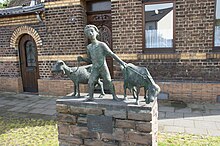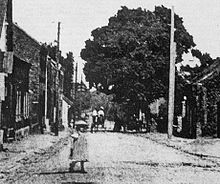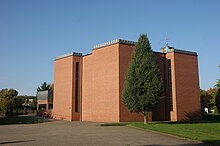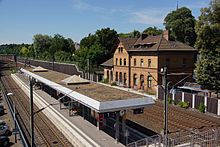Königsdorf (Frechen)
|
Königsdorf
City of Frechen
Coordinates: 50 ° 56 ′ 13 ″ N , 6 ° 46 ′ 17 ″ E
|
|
|---|---|
| Residents : | 11,788 (Dec. 31, 2016) |
| Incorporation : | 1st January 1975 |
| Postal code : | 50226 |
| Area code : | 02234 |
Königsdorf is the northernmost district of Frechen in the Rhein-Erft district . With 11,788 registered residents (as of December 31, 2016), it is the second largest district after Frechen city center.
The Königsdorf forest to the west and the diverse connections to the west of the neighboring city of Cologne are characteristic of Königsdorf . To the north are the Glessener Höhe and the town of Pulheim with the Brauweiler district, to the west of Königsdorf are the towns of Kerpen and Bergheim .
geography
Districts / neighborhoods
The settlement areas Großkönigsdorf, Kleinkönigsdorf, Neubuschbell and Neufreimersdorf belong to the district of Königsdorf. Großkönigsdorf, together with Kleinkönigsdorf, was spun off from the community of Lövenich and incorporated into the city of Frechen by the Cologne Act of November 5, 1974 on municipal reorganization with effect from January 1, 1975. On the basis of the same law, Neufreimersdorf was separated from the then existing community of Brauweiler and incorporated into the city of Frechen.
Neubuschbell
The young settlement area Neubuschbell immediately north of the A 4 was created after the Second World War as an operating settlement between the Frechener district Buschbell and then part of the municipality Lövenich district Great King Village. It grew into a normal housing estate. Neubuschbell is the only settlement area in Königsdorf that was already in the Frechen urban area before the municipal reorganization. At that time (January 1, 1975) its population was 269.
Neufreimersdorf
Neufreimersdorf is a settlement area to the east of the Königsdorf district of Frechen and becomes the Pulheim city limits in the north through the old Königsdorfer Flur In der Widdau , which has been built since 2005 , in the west through the country road (L91) leading from there to Brauweiler and the east-west Bounded in the direction of federal road 55. The settlement area, which originally belonged to the municipality of Freimersdorf and has belonged to the municipality of Brauweiler since 1927, came to the city of Frechen on January 1, 1975 with 669 inhabitants through the municipal reorganization. It developed around the country house built by Cologne paint manufacturer Theodor Joseph Horst in 1895. Around 1970 there were only a few farmsteads and a few houses in Neufreimersdorf. Today Neufreimersdorf is a district consisting mainly of single-family and row houses for people who mostly work in Cologne.
Kleinkönigsdorf

Kleinkönigsdorf is located in the northern area of the Königsdorf district. The villages of Groß- and Kleinkönigsdorf used to be separate. They grew together over time, so that it is difficult for outsiders to distinguish them. At its core, Kleinkönigsdorf still has the character of a small village. After the Second World War, residential buildings expanded to the north and west. In the early 1970s, the old Fronhof was torn down in favor of a large residential complex. A memorial cross from 1633 for a Swedish officer in the masonry of a house on Waldstrasse commemorates the horrors of the Thirty Years' War . The Magdalenenkapelle is a specialty . The origin of the Magdalenenkapelle goes back to a half-timbered chapel from 1751. Today's neo-Romanesque building was built in 1892 by the brothers Carl and Fritz Pauli. The baroque high altar is taken from the previous building. The Pauli brothers, who came from an old post holder family, had previously built the castle-like Pauli Villa with an extensive park southwest of Kleinkönigsdorf on the edge of the Königsdorf Forest (since 1919 the Schervier Sisters' monastery ; since 1962 also an old people's and nursing home (St. Elisabet-Heim The listed west portal on Sebastianusstraße was originally the representative entrance to the park and the villa. Its side posts mark the transition from the Roman Via Belgica , which crosses Königsdorf, to the Königsdorfer Forest). Kleinkönigsdorf has its own cemetery, which is located in the east of the village. After the closure of the Großkönigsdorf cemetery in 2014, he took over responsibility for the Königsdorf district. A monument has been dedicated to the goat, which used to be an important farm animal in Kleinkönigsdorf.
Großkönigsdorf
As a former street village on Aachener Strasse (L 361) and around the train station in Frechen-Königsdorf, Großkönigsdorf and its train station developed from the 1960s to the most recent times into a popular place to live directly on the western Cologne city limits with the park and Weiden-West ride car park for S-Bahn and tram connections. Residential building districts with spacious villas, single-family and terraced houses and sports facilities characterize the district to the south and north of Aachener Strasse. A non-uniform development on Aachener Straße, which runs from east to west, forms the elongated town center. Listed buildings such as the former Benedictine convent, the St. Sebastianuskirche from 1879, the station building, the Mellerhof, which dates back to a Franconian courtyard, and individual residential buildings from the 19th century alternate with retail stores, two bank branches and modern residential buildings. South of Aachener Strasse is the district's second center for the elderly (St. Augustinus), attached to the Sacred Heart Monastery of the Augustinian Women Cooperative founded in 1894.
The stoneware industry of European importance with the companies Großpeter-Lindemann and Hensmann, which had a strong influence on the district from the end of the 19th century until the 1970s, had its own rail connections. It was abandoned in the 1980s and 1990s. The associated Großpeter-Lindemann factory halls and buildings south of the listed station building were converted into loft apartments and commercial premises in the 1990s and have served as a commercial and technology park (GTP) ever since. The Hensmann plant north of the railway facilities with the director's villa of the company founder Franz Hensmann was finally cleared from 2008 in favor of supermarkets after being used as a warehouse by a Finnish furniture manufacturer in the 1970s.
The area around the old St. Sebastianuskirche offers space for a large number of foreign bird species that were released into the wild in the 1950s by a migratory zoo located there.
history
Roman settlement remains in Klein- and Großkönigsdorf have been known since the end of the 19th century. In 2004 one of the most important Roman manors in the Rhineland was discovered and built over during the development of the Großkönigsdorfer Flur “In der Widdau”. An information board at the entrance to the building area indicates the history of villa rustica. The manors supplied the Roman Cologne for four centuries, with which it was connected via what is now known as the Via Belgica . This trade and military route connected Roman Cologne with the North Sea. Their traces only partially left in the field before Neufreimersdorf, as a route along the Dechant-Hansen-Allee in Großkönigsdorf, marked by the pillars of the west portal of the Pauli-Villa and especially in the Königsdorf forest, in the one on the road beyond the city limits The ground monument Heidenburg was recognized as a Roman road post, are marked by VIA signs and sponsored information boards in connection with the Römerstrasse adventure space project of the Rhineland Regional Council.
The so-called Königslinde, which stood until 1909 and, according to legend, was planted on the site of a chapel in which Charlemagne is said to have met the later Cologne bishop Hildebold, can be considered a landmark of Königsdorf. The Benedictine monastery Königsdorf was first mentioned in a document in 1136. Legends about the founding go back a long way. In 1802 the monastery was abolished and profaned by the French. A late Gothic crucifixion group on the monastery wall was replaced by a weatherproof copy in 1981 and the original was transferred to the Hildebold Church. Parts of the monastery complex (including the immunity wall ) have been placed under monument protection since the 1980s and converted into residential buildings. Residential houses were built over open spaces.
Since the Middle Ages , Königsdorf has been an office in Kurköln with a castle as a customs post . This also included the places Brauweiler, Dansweiler , Manstedten and Sinthern . Kleinkönigsdorf was associated with the "glory" of Brauweiler, a subordinate rule in the territory of the Electorate of Cologne . Under French occupation, Groß- and Kleinkönigsdorf were part of the Mairie de Loevenich, later they belonged to the municipality of Lövenich, then together with the municipality of Brauweiler to the office of Lövenich, which was renamed the office of Weiden in 1937. The Second World War ended there with the invasion of the 415th US Infantry Regiment of the 104th Infantry Division on March 4, 1945. Königsdorf remained part of the community of Lövenich and thus part of the Weiden office and the old district of Cologne until the municipal reorganization . which came into force on January 1, 1975. They made Königsdorf with 5534 inhabitants the largest suburb of Frechen, it was incorporated into the new Erft district, which was renamed the Rhein-Erft district in 2003 .
Religious communities
Up to the end of the 19th century, the large and small king villages were dominated by Catholics . The Catholic parish of St. Sebastianus was established in 1888. Before that, the Großkönigsdorf parish belonged to the parish of St. Ulrich in Buschbell and the Kleinkönigsdorf to the parish of St. Nikolaus in Brauweiler. The St. Sebastianuskirche, planned by the diocesan master builder Heinrich Johann Wiethase and consecrated in 1879, is a listed building. It was no longer sufficient for the influx of new citizens in the 1960s and 1970s. Today it is only used for individual church events. A new parish church was planned near the Johannesschule by the Cologne architect Günter Hagen and consecrated in 1976. It is dedicated to the Polish saint Andreas Bobola and, together with the parsonage and library, which was built at the same time, forms the church Hildebold center. In local usage, the term "Hildebold Church" has established itself. The Königsdorf Catholic parish has been part of the Frechen parish community since 2008.
It was only with industrialization and with the refugees after the Second World War that Protestants also came to Groß- and Kleinkönigsdorf. The community district Groß- und Kleinkönigsdorf of the evangelical parish of Weiden was able to build its own simple church, the Christ Church, for its then 800 parishioners in 1960, also near the Johannesschule. The architect was Siegfried Knoch. As the community grew, a community center was added in 1982. In 2010 the district had around 2000 members. Since January 2015, the congregation has formed a separate congregation with the Christ congregation in Brauweiler.
The Catholic parish of St. Sebastianus Königsdorf and the parish of Königsdorf have been working together since January 2000 on the basis of a long ecumenical tradition promoted by the Catholic and Protestant pastors Hans-Joachim Kampmann and Helmut Schmale and an official parish partnership agreement with the express approval of the respective church leaders.
Johanness School
The Johannesschule is an open all-day school in Königsdorf.
It was built as a Catholic elementary school in 1907 at its current location, Friedrich-Ebert- Strasse, on the border between Klein- and Großkönigsdorf. The intention of this localization was an intended organic coalescence of the districts. The new building replaced the old school on Aachener Straße in Großkönigsdorf. In 1927, the Kleinkönigsdorfer School (until then near the Kleinkönigsdorfer Friedhof) was incorporated.
In 1952 an extension was inaugurated. A year later, a Protestant primary school was housed in the rooms of the Catholic primary school. The Johannesschule was given its name in 1966, named after Pope Johannes XXIII, who had died three years earlier . In the year it was named, the school was expanded again due to the increased number of students. In the following year, the Protestant primary school was converted into a community elementary school. Because of the new school law that came into force on March 1, 1968 after a constitutional amendment in North Rhine-Westphalia , the elementary school was divided into primary and secondary schools - the secondary school was set up in neighboring Weiden , while the primary school remained at the previous location.
From 1969 to 1973 part of the new building was temporarily used as a school building for a new grammar school in Weiden, where up to 900 students were accommodated. In 1971 the Johannesschule and the community school were merged into one school. After the grammar school moved out in 1973, a school for physically handicapped children temporarily moved into the timber building to the south by 1982 .
In 2006 the Johannesschule became an open all-day school , and the space required for this was ensured by two group rooms in container construction. Since 2014, every age group has had a pure OGS class and mixed-class OGS groups, with two additional container rooms being rented. The only elementary school in Königsdorf is undergoing extensive renovation and renovations due to its growing space requirements.
traffic
Train
In 2000 the DB - Großkönigsdorf station on the upgraded Cologne-Aachen line was renamed Frechen-Königsdorf . Since 2002, Frechen-Königsdorf has been a stop for the Cologne S-Bahn after the line was extended to four tracks .
The Frechen-Königsdorf stop is served by the following lines for local rail passenger transport (as of December 13, 2015):
| line | Line designation | Line course |
|---|---|---|
| S 12 | S-Bahn Cologne | ( Horrem - Frechen-Königsdorf -) Cologne-Ehrenfeld - Cologne Hbf - Troisdorf - Hennef (Sieg) - Herchen - Au (Sieg) |
| S 13 | S-Bahn Cologne | ( Aachen Hbf - Aachen-Rothe Erde - Stolberg - Langerwehe -) * Düren - Horrem - Frechen-Königsdorf - Cologne-Ehrenfeld - Cologne Hbf - Cologne / Bonn Airport - Troisdorf |
| S 19 | S-Bahn Cologne | Düren - Horrem - Frechen-Königsdorf - Cologne-Ehrenfeld - Cologne Hbf - Cologne / Bonn Airport - Troisdorf - Hennef (Sieg) - Herchen - ( Au (Sieg) ) * 1 |
* : At night one trip beyond Horrem to Aachen main station and back.
* 1 : Mondays to Fridays to Herchen, 3 pairs of trips during the weekday lunchtime and night traffic on weekends to Au.
Highway
The motorway junction closest to Königsdorf is " Köln-Lövenich " on the A1 (exit 103). Even closer, but only in and from Aachen , is the “Frechen-Nord” sub- junction, completed in June 2006, on the A4 (exit 9a). In December 2016, an application was made for the connection to be fully expanded, and Bonnstrasse (L 183) from Aachener Strasse to Frechener Krankenhausstrasse should also be expanded to four lanes. A partial junction of the A4 towards Cologne has been under construction west of Königsdorf since 2014. The “ Frechen ” junction of the A1 (exit 104), located to the southeast, is also relatively close to Königsdorf.
Traffic history
In 1840 Königsdorf received a station for the Rheinische Eisenbahngesellschaft on the Cologne-Belgium route, Germany's 7th railway line. In 1891 the station building was replaced by a more modern one, which retained this function until 1991. The train station was converted into an S-Bahn station without a railway building. The building was placed under a preservation order and sold to private customers. The former 1623 m long Königsdorf railway tunnel - also known as the Horrem tunnel - has crossed the Villerücken since 1841 . This breakthrough was a technical masterpiece at the time and the largest construction site in Europe with up to 2000 workers from all over Europe. While the first tunnel was on German soil between Dresden and Leipzig, the Königsdorf tunnel was the oldest tunnel on the Deutsche Bundesbahn. Frequently necessary maintenance work and new traffic-related requirements demanded that the tunnel be cut open in 1955 after 114 years of operation. As a souvenir, the east portal of the tunnel entrance with an information board was preserved and was placed under monument protection.
On May 26, 1983, seven people died in a train accident in Königsdorf on the Aachen-Cologne railway line ; 23 other people were injured, some seriously. The cause of the accident was the flooding of private property, which derailed the Ostend-Vienna Express . The electric locomotive slipped off track and hit a road bridge. Among other things, one of the following wagons was bent over in the middle due to the force of the impact.
Associations and societies (without development associations)
- Antenne-Erftland e. V.
- Tennis Club Rot-Weiß Königsdorf e. V.
- Gymnastics and Sports Club Blau-Weiß Königsdorf 1900 e. V. (TuS)
- St. Sebastianus Schützenbruderschaft Königsdorf 1683 eV
literature
- Egon Heeg, Axel Kurth, Peter Schreiner (eds.): Königsdorf in the Rhineland. Pulheim Contributions to History, 34th special publication, Pulheim, ISBN 978-3-927765-53-5 .
- Paul Clemen : Die Kunstdenkmäler des Landkreis Köln , Düsseldorf 1897, reprint: Verlag Schwann-Bagel, Düsseldorf 1983, ISBN 3-590-32118-0 , pp. 10-144, 159.
- Helmut Weingarten: Königsdorf , Cologne 1989, ISBN 3-7927-1066-8 .
- Helmut Weingarten: The railway between the Rhine and Erft , pp. 9–19, 65–68, ISBN 3-7927-0973-2 .
- Heinz Wolter: The Benedictine Monastery of Königsdorf , in: Erftkreis Hrsg .: Monasteries and Stifts in the Erftkreis , Hürth 1988, ISBN 3-7927-1044-7 , pp. 227-254.
- Heinz Wolter: History of the Benedictine monastery Königsdorf , 11th special publication Pulheimer contributions to history and local history, Pulheim 1995, ISBN 3-927765-14-7 .
- Helmut Weingarten: The branches of the order in the 19th and 20th centuries , in: Erftkreis Hrsg .: Monasteries and Stifts in the Erftkreis , Hürth 1988, ISBN 3-7927-1044-7 , p. 286 f.
- Frank Kretzschmar: Churches, monasteries and chapels in the Erftkreis , Erftkreis publication no. 92, ISBN 3-7927-0821-3 , p. 132 f, p. 160-173.
- various contributions by Joseph Sander and Paul Stelkens in various editions and volumes of
- Pulheimer contributions to history and local history
- Yearbook of the Frechener Geschichtsverein e. V.
- Publications of the archive of the city of Frechen
Web links
- Königsdorf , Frechener Geschichtsverein ( page no longer available )
Individual evidence
- ↑ On the settlement areas Peter Schreiner: Kleinkönigsdorf-Großkönigsdorf-Neufreimersdorf-Neubuschbell. In: Egon Heeg, Axel Kurth, Peter Schreiner (eds.): Königsdorf im Rheinland. P. 13 ff.
- ^ Walter Meyer, Siegfried Offermann, Peter Schreiner In: Egon Heeg, Axel Kurth, Peter Schreiner (eds.): Königsdorf im Rheinland. P. 762 ff.
- ↑ Peter Schreiner: Kleinkönigsdorf, a place in the glory of Brauweiler. In: Egon Heeg, Axel Kurth, Peter Schreiner (Eds.): Pp. 222 ff., 231 f.
- ↑ Helmut Weingarten: The Villa Pauli - The St. Elisabeth Home , In: Egon Heeg, Axel Kurth, Peter Schreiner (Ed.): Königsdorf im Rheinland. P. 516 ff.
- ^ Paul Stelkens: The West Portal to the Pauli Villa , in Pulheimer Contributions to History, Volume 39, 2014, p. 81 ff .; extended version The west portal to the Pauli Villa in Königsdorf. A historical landmark of the 19th century in decline , 2016, (Ed.) Stadtarchiv Frechen
- ^ Helmut Weingarten: Goat breeding in Kleinkönigsdorf. In: Egon Heeg, Axel Kurth, Peter Schreiner (eds.): Königsdorf im Rheinland. P. 760 ff.
- ↑ Klein-Königsdorf's animal side. In: Kölner Stadt-Anzeiger. December 6, 2012, accessed July 7, 2015 .
- ^ Egon Heeg: The "Aachener Straße" in Königsdorf - The story of a relationship . In: Egon Heeg, Axel Kurth, Peter Schreiner (eds.): Königsdorf im Rheinland , p. 75 ff.
- ^ Helmut Weingarten: Herz-Jesu-Kloster - Altenzentrum St. Augustinus. In: Egon Heeg, Axel Kurth, Peter Schreiner (eds.): Königsdorf im Rheinland , p. 523 ff.
- ^ Werner Madsack: stoneware production in Königsdorf. In: Egon Heeg, Axel Kurth, Peter Schreiner (eds.): Königsdorf im Rheinland , p. 382 ff.
- ↑ Paul Stelkens: The Hensmann Villa in Großkönigsdorf - A plea for monument protection, at the same time a contribution to the building history of Königsdorf in the vicinity of its 170-year-old train station. In: Egon Heeg, Axel Kurth, Peter Schreiner (eds.): Königsdorf im Rheinland , p. 402 ff.
- ↑ Stefanie Troll: 350 years of Roman life on an estate in Frechen-Königsdorf. In: Egon Heeg, Axel Kurth, Peter Schreiner (eds.): Königsdorf im Rheinland. P. 23 ff .; http://www.stadtarchiv-frechen.de/images/03_Stadtgeschichte/veroeffnahmungen/media/2014-09-11_Vortrag_R%C3%B6mer_Internet.pdf
- ↑ Wolfgang Mrziglod: Where “Via” is written, there is also a way. In: Kölner Stadt-Anzeiger from March 26, 2015.
- ↑ Archived copy ( memento of the original from July 14, 2015 in the Internet Archive ) Info: The archive link was inserted automatically and has not yet been checked. Please check the original and archive link according to the instructions and then remove this notice.
- ↑ Peter Schreiner: Königsdorf and Hildebold - How a legend comes about , In: Pulheimer Contributions to History Volume 37, 2012, pp. 190 ff.
- ↑ Heinz Wolter: The former Benedictine convent Königsdorf 1136-1802 , In: Egon Heeg, Axel Kurth, Peter Schreiner (ed.): Königsdorf im Rheinland. P. 139 ff.
- ↑ Helmut Weingarten: The rediscovery of the Königsdorf assistant figures . In: Egon Heeg, Axel Kurth, Peter Schreiner (eds.): Königsdorf im Rheinland. P. 710 ff.
- ↑ Peter Schreiner: Kleinkönigsdorf, a place in the glory of Brauweiler , In: Egon Heeg, Axel Kurth, Peter Schreiner (ed.): Königsdorf im Rheinland. P. 222 ff.
- ↑ Helmut Weingarten, Königsdorf, 1989, p. 149 ff .; Paul Stelkens, prisoner of war and forced labor in Königsdorf. At the same time, a contribution to the history of the Königsdorf war victims graves and the end of the war in Königsdorf on March 4, 1945 , 2015, p. 87 f.
- ↑ http://www.stadtarchiv-frechen.de/images/03_Stadtgeschichte/veroeffnahmungen/media/2014-11-10_Vortrag_Gro%C3%9Fangriff_auf_K%C3%B6ln.pdf
- ^ Federal Statistical Office (ed.): Historical municipality directory for the Federal Republic of Germany. Name, border and key number changes in municipalities, counties and administrative districts from May 27, 1970 to December 31, 1982 . W. Kohlhammer, Stuttgart / Mainz 1983, ISBN 3-17-003263-1 , p. 301 .
- ↑ Helmut Fußbroich, The Catholic churches of Frechen-Königsdorf. In: Egon Heeg, Axel Kurth, Peter Schreiner (eds.): Königsdorf im Rheinland. P. 552 ff.
- ^ Marianne Madsack, The Evangelical Community of Königsdorf, in: Egon Heeg, Axel Kurth, Peter Schreiner (eds.): Königsdorf in the Rhineland. P. 686 ff .; Uta Böker: Simple but also idiosyncratic in the Kölner Stadtanzeiger, Rhein-Erft, from 30./31. January 2010, p. 45 and online with picture of the church on January 29, 2010 , accessed on August 15, 2017 (German)
- ↑ Paul Stelkens, A Pastor for Königsdorf , Frechen City Archives, 2003 (accessed on August 15, 2017)
- ↑ Community partnership agreement of January 16, 2000 (from page 35 of the PDF document; 442 kB) ( Memento of the original of July 8, 2015 in the Internet Archive ) Info: The archive link has been inserted automatically and has not yet been checked. Please check the original and archive link according to the instructions and then remove this notice.
- ↑ Herwart Griese, The school in Königsdorf, In: Egon Heeg, Axel Kurth, Peter Schreiner (ed.): Königsdorf im Rheinland. P. 482 ff.
- ^ Kölner Stadt-Anzeiger , Rhein-Erft-Kreis: New Johannesschule is getting bigger (from March 17, 2014)
- ↑ Martin Mirgel, Oliver Wruck: Plan approval procedure for the expansion of the L 183 between K 6 and L 361 with full expansion of the Frechen-Nord AS and A4 interweaving strips in Frechen, Cologne, Bergheim and Kerpen. Retrieved August 15, 2017 .
- ↑ Pamo Roth: Autobahn connection Königsdorf: Construction road for A4 connection soon ready . In: Kölner Stadt-Anzeiger . ( ksta.de [accessed on August 15, 2017]).
- ↑ Helmut Weingarten, When the locomotives learned to run, In: Egon Heeg, Axel Kurth, Peter Schreiner (eds.): Königsdorf im Rheinland. P. 331 ff .; another., A tunnel disappeared, there p. 378 ff.








